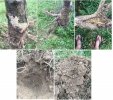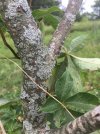j-bird
Moderator
So I have a plot where I planted 4 3 gallon dunstan chestnuts a few years back. Slowly but surely they have all died but one. They will get 8+ feet tall...one even just started to produce nuts...and then they decline quickly and die. I was told that one did due to root rot. So I am wondering if the soil in that immediate area is holding too much water. The soil here is generally a sand loam with very little clay at all. You can even make a good mud ball in most cases.
So as a result I have 1 left. But my nearest other chestnuts are roughly a 1/4 to 1/2 mile south and are much younger (maybe only a few feet tall). I am considering planting a could chinese in the plot in question... The only reason I tried the dunstan was to try to stay more native if possible, but I just want deer food in the end. I like the idea of mast trees as a food source I don't have to baby sit once I'm to old to be dicking with food plots. This same plot I have sawtooth that seem to be doing very well, so it's not like it's a swamp. But there is an area real close that will puddle for a day or so after a good rain.
Am I wasting my time with the chinese? Will the chinese pollinate the dunstan?
So as a result I have 1 left. But my nearest other chestnuts are roughly a 1/4 to 1/2 mile south and are much younger (maybe only a few feet tall). I am considering planting a could chinese in the plot in question... The only reason I tried the dunstan was to try to stay more native if possible, but I just want deer food in the end. I like the idea of mast trees as a food source I don't have to baby sit once I'm to old to be dicking with food plots. This same plot I have sawtooth that seem to be doing very well, so it's not like it's a swamp. But there is an area real close that will puddle for a day or so after a good rain.
Am I wasting my time with the chinese? Will the chinese pollinate the dunstan?



